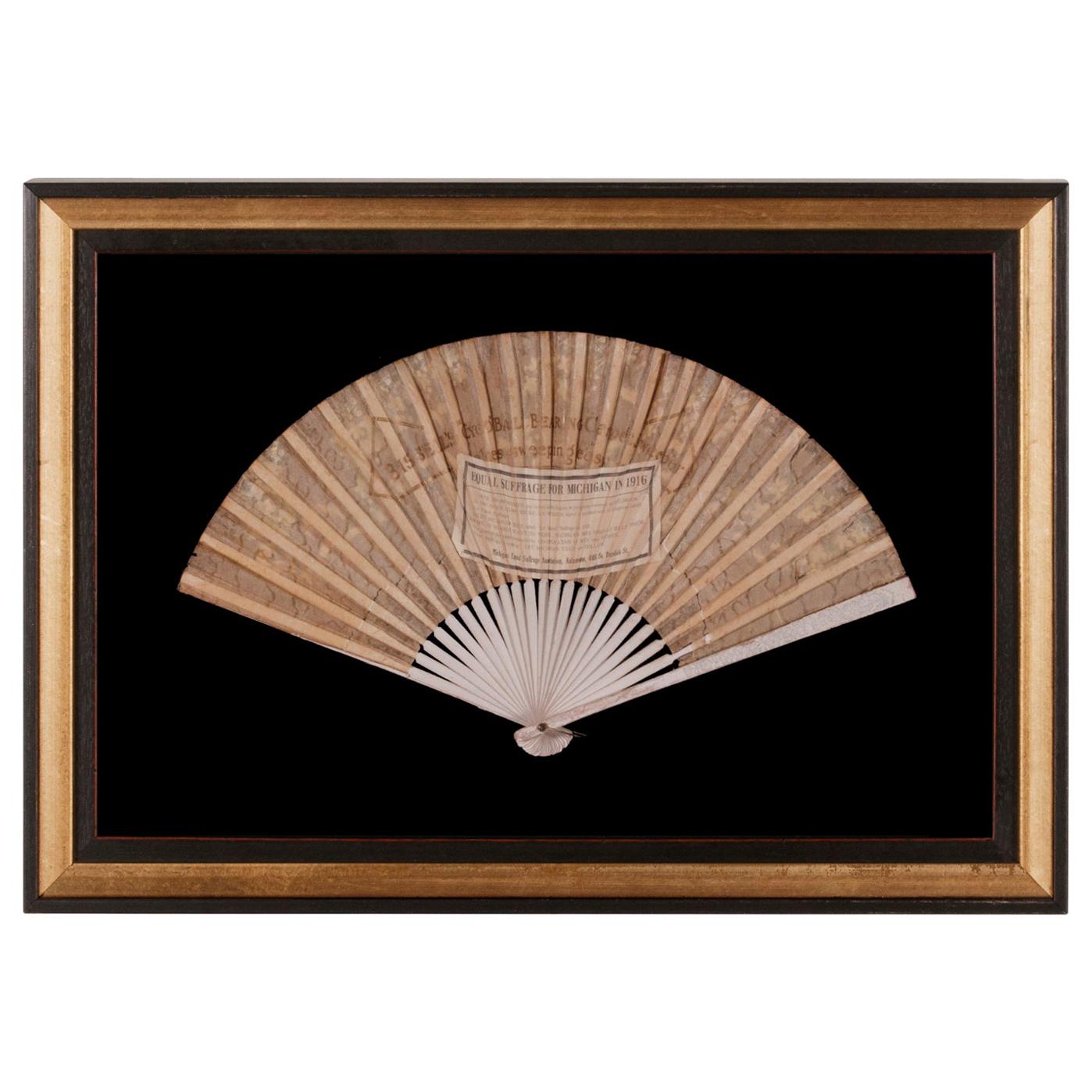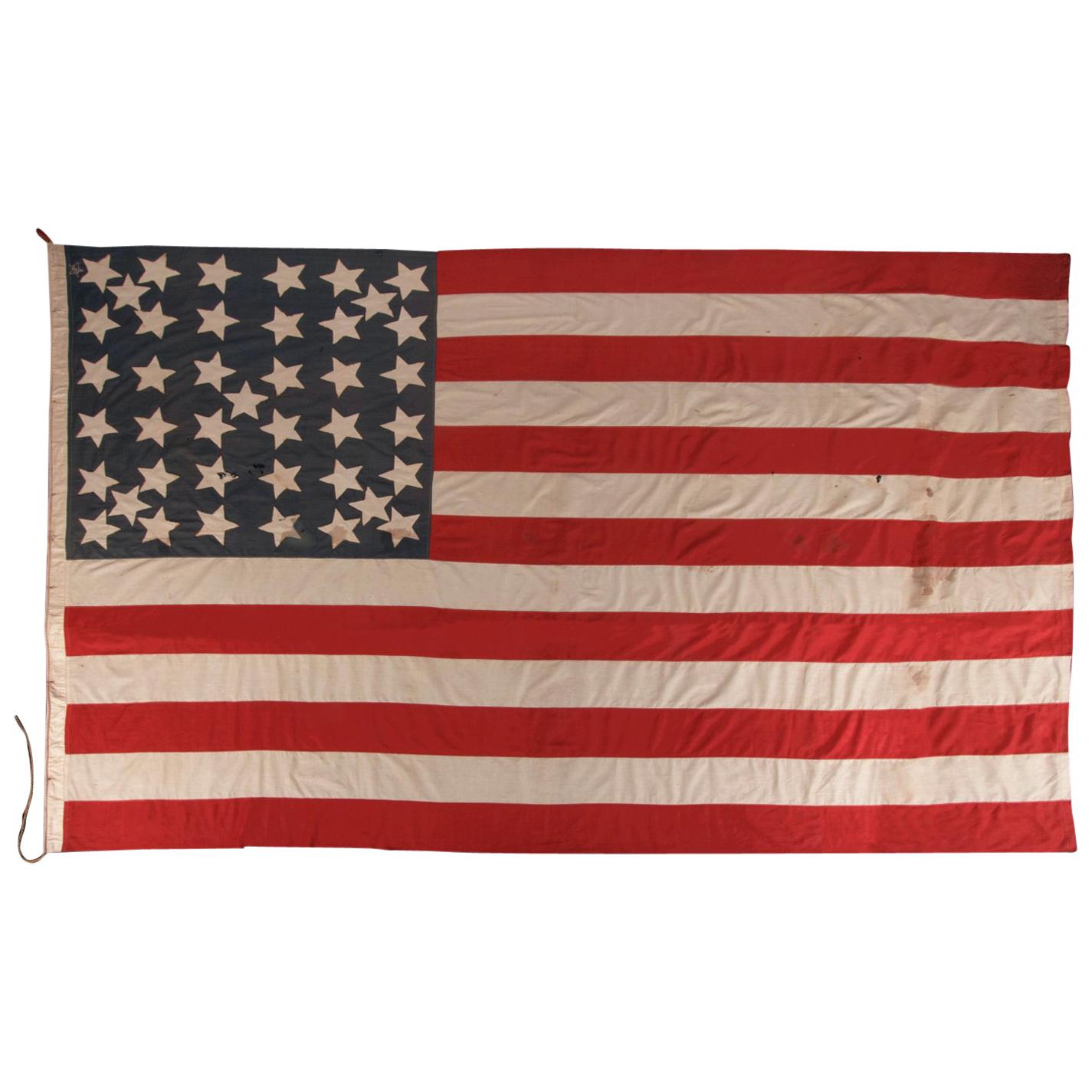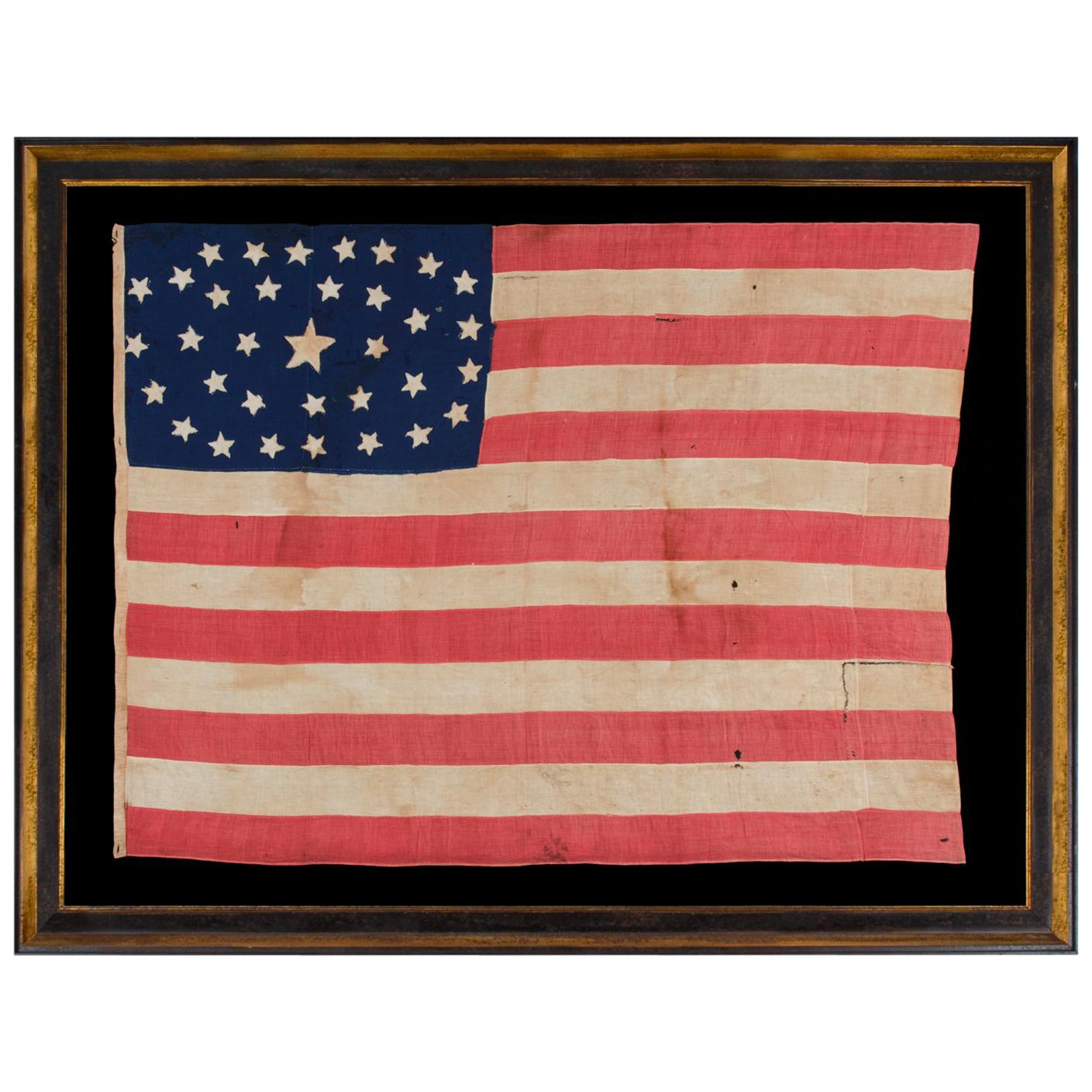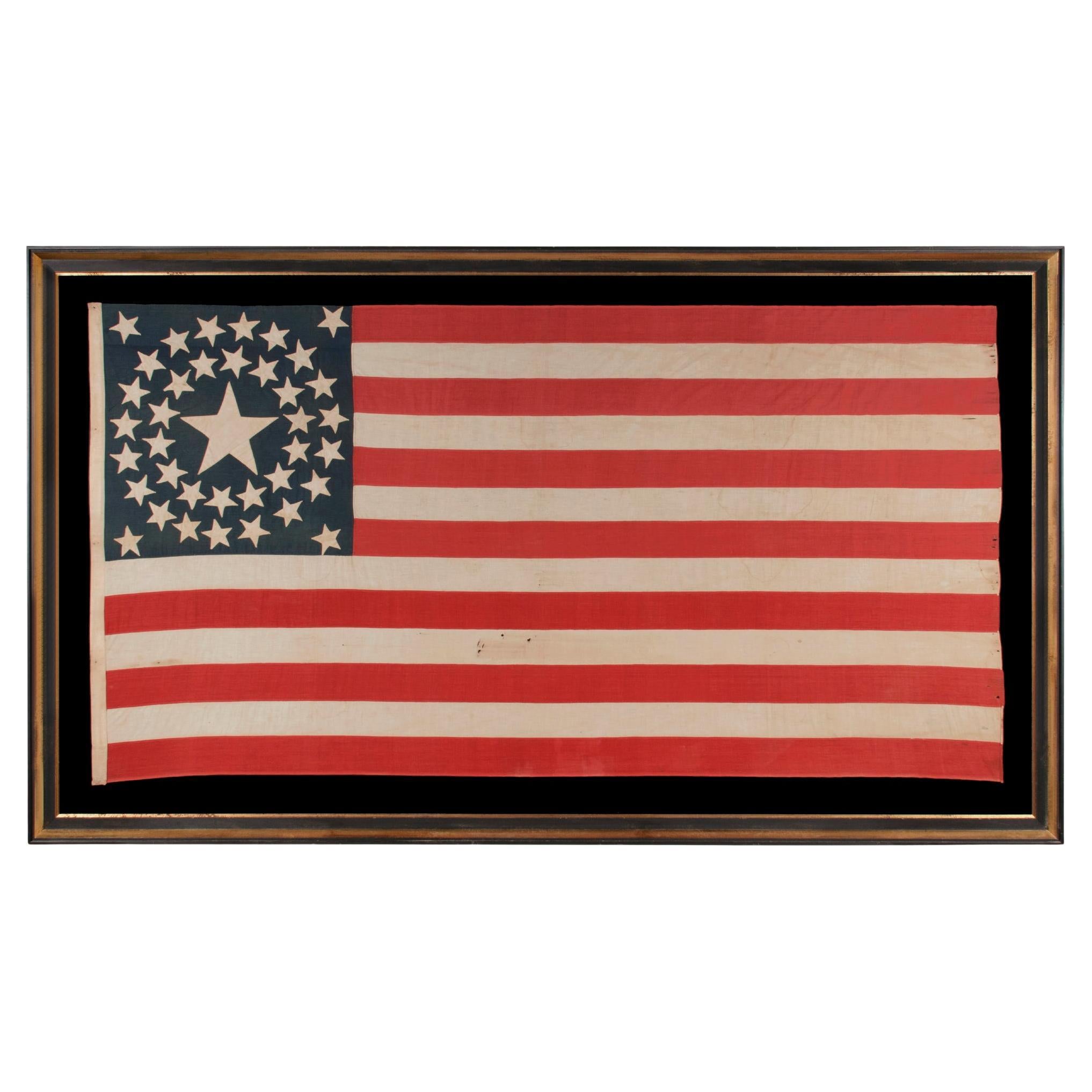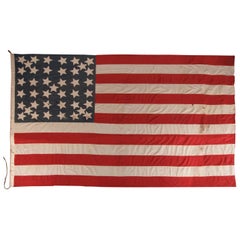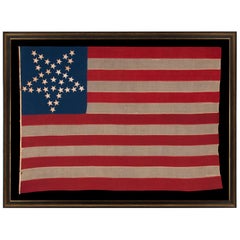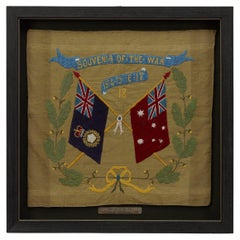
48 Stars Configured into the Letters "U.S.A", Copyrighted in 1916 by C.A Hartman
View Similar Items
Want more images or videos?
Request additional images or videos from the seller
1 of 6
48 Stars Configured into the Letters "U.S.A", Copyrighted in 1916 by C.A Hartman
About the Item
- Dimensions:Height: 57.5 in (146.05 cm)Width: 84 in (213.36 cm)Depth: 2.5 in (6.35 cm)
- Place of Origin:
- Period:1910-1919
- Date of Manufacture:1916
- Condition:See item Description.
- Seller Location:York County, PA
- Reference Number:1stDibs: LU84976131823
About the Seller
5.0
Recognized Seller
These prestigious sellers are industry leaders and represent the highest echelon for item quality and design.
Established in 1991
1stDibs seller since 2008
60 sales on 1stDibs
Typical response time: 13 hours
More From This SellerView All
- "Equal suffrage for Michigan in 1916" Advertising Fan for the Bissell CompanyLocated in York County, PA"EQUAL SUFFRAGE FOR MICHIGAN IN 1916," ADVERTISING FAN FOR THE BISSELL 'CYCO BALL BEARING CARPET SWEEPER,' COMMISSIONED BY ANNA BISSELL (1846-1934), AMERICA'S FIRST FEMALE CEO Oriental-made, twill-woven silk fan with gilt lettering that reads : "Bissell's 'Cyco Ball Bearing Carpet Sweeper' makes sweeping easy," set within an interesting, open, geometric design. A purposefully curved, paper label beneath was applied by the "Michigan Equal Suffrage Association, Kalamazoo, 405 So. Burdick St.," whose byline is along the bottom. On it, a terrific message reads: "OVER 100,000 WOMEN pay taxes in Michigan on property assessed at $177,596,938. In 1910 OVER 175,000 MICHIGAN WOMEN signed a petition sent to Congress asking for Equal Suffrage. 247,373 MICHIGAN MEN voted...Category
Vintage 1910s American Political and Patriotic Memorabilia
MaterialsSilk
- 41 Stars In a Lineal Pattern With Offset Stars, Montana Statehood American FlagLocated in York County, PA41 STARS IN A LINEAL PATTERN WITH OFFSET STARS THAT CREATE A CROSSHATCH IN THE CORNERS AND CENTER, ONE OF THE RAREST STAR COUNTS AMONG SURVIVING FLAGS OF THE 19TH CENTURY, REFLECTS MONTANA STATEHOOD IN NOVEMBER, 1889, ACCURATE FOR JUST 3 DAYS: Numerous flags appeared with unofficial star counts in early America, produced by flag-makers in anticipation of the addition of more states. The 41 star flag...Category
Antique 1880s American Political and Patriotic Memorabilia
MaterialsCotton
- 36 Star Antique Flag, Nevada Statehood, with Stars in the "Great Star" PatternLocated in York County, PA36 STARS IN THE "GREAT STAR" OR "GREAT LUMINARY" PATTERN, ON A MERINO WOOL FLAG OF THE CIVIL WAR ERA WITH BEAUTIFUL SCARLET AND ROYAL BLUE COLOR AND WITH ITS CANTON RESTING ON THE "WAR STRIPE," REFLECTS NEVADA STATEHOOD, 1864-67 36 star antique American flag of the Civil War era, with some rare, desirable, and beautiful features. The most obvious of these is the configuration of the stars. These are arranged in what is known as the “Great Star” or "Great Luminary" pattern, a star made out of stars, which is one of the most graphic and desired geometric designs among flag enthusiasts. Nevada entered the Union as the 36th state on October 31st, Halloween, in 1864. Ushered in by Abraham Lincoln just eight days before the presidential election that resulted in his second term, the territory’s wealth in silver was attractive to a nation struggling with the debts of war and so increased support for the Republican ticket. The 36th star was officially added on July 4th, 1865, but since the flag makers generally cared very little about official star counts, the production of 36 star flags began much earlier. The makers of printed flags are known to have begun adding the 36th star as early as July of 1864, several months before the addition of Nevada actually occurred. This was a common practice during the late 19th century and is reflective of both the nation's desire for Westward Expansion and the hope of flag-makers to bring new star counts to market before their competitors. The 36 star flag was officially replaced by the 37 star flag in 1867, following the addition of Nebraska. Great Stars come in many forms. This particular example has a single center star, surrounded by a pentagon of 5 stars, set inside its star-shaped perimeter. Note how the Great Star is positioned with two points up instead of one and so is effectively upside-down with respect to modern convention. Unlike the current flag, versions of the Stars & Stripes made during the 19th century and prior often displayed stars that were varied or completely random in their rotation on a vertical axis. Note how the feature draws attention and is unusual to the eye, in addition to being visually appealing. Another interesting trait can be seen in the fact that the canton rests on a red stripe. When this scarce condition occurs, some flag historians have referred to it as the “blood stripe” or the “war stripe”, suggesting the flag was constructed in this manner when the nation was at war. In actuality, the placement probably occurred more often by accident. Not everyone knew where the canton was traditionally positioned, and because there was no official specification until 1912, there was no official placement. Whatever the case may be with regarding the reason, the war stripe feature is highly coveted by collectors. The stars of the flag are hand-sewn, made of cotton, and are double-appliquéd (applied to both sides). The canton and stripes of the flag are made of fine merino wool. These are beautiful, luxurious fabrics with strong royal blue and scarlet color. Every seam was joined with a row of hand-stitching, then finished with a row of treadle stitching. Instead of employing the selvage edge of the red fabric, the top and bottom edges of the flag were turned under and seamed by hand and the fly end was seamed in the same fashion. There is a narrow binding along the hoist, treadle-sewn and made of cotton. Along this five cotton tabs were affixed, each with a tiny brass ring, which suggests that the flag was probably affixed to a wooden staff with twine or ribbon and hand-carried. The name of "Stow" is inscribed along the hoist. This would be the name of a former owner. In the field of early American flags...Category
Antique 1860s American Political and Patriotic Memorabilia
MaterialsWool
- 34 Star American flag, Updated to 39 Stars, with Stars in a Great Star PatternLocated in York County, PA34 STARS IN A WHIMSICAL RENDITION OF THE GREAT STAR PATTERN, ON A CIVIL WAR PERIOD FLAG WITH A CORNFLOWER BLUE CANTON, UPDATED TO 39 STARS IN 1876 34 star American national flag with additional stars added and one of the most stunning graphic designs I have ever seen in early flag-making. The original pattern was comprised of a circle of 5 large stars, and triangular arms made of smaller stars. These are noticeable pointy and bent like the arms of a starfish. Made of cotton, the stars are hand-sewn and double-appliquéd to a fantastic, cornflower blue canton, a color common to Civil War uniforms...Category
Antique 1870s American Political and Patriotic Memorabilia
MaterialsCotton
- 13 Star American Flag with Hand-Sewn Stars in the 3rd Maryland PatternLocated in York County, PA13 hand sewn stars in a circular version of what is known as the 3rd Maryland pattern, with an especially large center star, a flag with especially tiny scale among those with pieced-and-sewn construction, exceptionally rare, made circa 1890: 13 star flags have been flown throughout our nation’s history for a variety of purposes. They were hoisted at patriotic events, including Lafayette’s visit in 1824-25, the celebration of the centennial of American independence in 1876, and the sesquicentennial in 1926. They were displayed during the Civil War, to reference past struggles for American liberty and victory over oppression, and were used by 19th century politicians while campaigning for the same reason. As the number of stars grew with the addition of new states, it became more and more difficult to fit their full complement on a small flag. The stars would, by necessity, have to become smaller, which made it more and more difficult to view them from a distance as individual objects. The fear was that too many of them close together would become as one white mass and distort the ability to identify American ships on the open seas. Keeping the count low allowed for better visibility. For this reason the U.S. Navy flew 13 star flags on small boats. Some private ship owners mirrored this practice and flew 13 star flags during the same period as the Navy. Flag experts disagree about the precisely when the Navy began to revert to 13 stars and other low counts. Some feel that the use of 13 star flags never stopped, which seems to be supported by depictions of ships in period artwork. This was, of course, the original number of stars on the first American national flag, by way of the First Flag Act of 1777, and equal to the number of original colonies that became states. Any American flag that has previously been official remains so according to the flag acts, so it remains perfectly acceptable to fly 13 star flags today by way of congressional law. Since there was no official star configuration until the 20th century (1912 specifically, beginning with the 48 star count), the stars on 13 star flags may appear in any one of a host of configurations. Some of these are more rare and desirable than others. The stars of this particular flag are arranged in what has come to be known as the "3rd Maryland Pattern." This configuration, whether oval or circular, is appreciated both for its visual appeal and the scarcity of its use. a circular wreath of 12 with a single star in the center. The name comes from a flag that resides at the Maryland State Capitol in Annapolis, long thought to have been present with General Daniel Morgan at the Battle of Cowpens in 1781. According to legend, the flag was supposed to have been carried by Color Sergeant William Batchelor of the 3rd Maryland Light Infantry and was donated to the State of Maryland by Batchelor's descendants. The story was disproved in the 1970's, however, following an examination by the late flag expert Grace Rogers Cooper of the Smithsonian, who discovered that the Cowpens flag was, at the earliest, of Mexican War...Category
Antique 1890s American Political and Patriotic Memorabilia
MaterialsWool
Price Upon Request - 13 Hand-Sewn Stars, In an Oval Version of the 3rd Maryland PatternLocated in York County, PA13 HAND-SEWN STARS, IN AN OVAL VERSION OF THE 3RD MARYLAND PATTERN, ON AN ANTIQUE AMERICAN FLAG MADE IN THE PERIOD BETWEEN THE CIVIL WAR (1861-65) AND THE 1876 CENTENNIAL OF AMERICAN...Category
Antique 1860s American Political and Patriotic Memorabilia
MaterialsWool
Price Upon Request
You May Also Like
- "The Second World War, " by Winston ChurchillBy Houghton Mifflin & Co.Located in Austin, TXThe Second World War by Winston Churchill from Houghton-Mifflin Company, Boston. A vintage edition of Winston Churchill's six-volume memoir, The Second World War, for which he was a...Category
Mid-20th Century American Modern Books
MaterialsPaper
- 1868 Map of the Upper Part of the Island of Manhattan Above 86th StreetBy Wm. Rogers Mfg. Co.Located in San Francisco, CAThis wonderful piece of New York City history is over 150 years old. It depicts 86th street and above. It was lithographed by WC Rogers and company. It was made to show what was the Battle of Harlem during the Revolutionary war...Category
Antique 1860s American American Colonial Maps
MaterialsPaper
- Souvenir of the War 1914-15-16-17-18 BannerLocated in Colorado Springs, COPresented is a stunning textile banner from the first World War, dating to 1918. The square tan cotton cloth is embroidered with two crossed flags, the ...Category
Vintage 1910s Australian Political and Patriotic Memorabilia
MaterialsCotton
- Fathers of the Air Service Authentic Signature Collage, circa 1926-1993Located in Colorado Springs, COPresented is a collage celebrating the men who made an early impact on the formation of America’s Air Service. Complete with signatures by Jimmy Doolittle, Tooey Spaatz, Hap Arnold, ...Category
Late 20th Century American Historical Memorabilia
MaterialsPaper
- Mr. Dooley at His Best, by Finley Peter Dunne Edited by Elmer EllisLocated in valatie, NYMr. Dooley at His Best. Edited by Elmer Ellis at the University of Missouri. With a Foreword by Franklin P. Adams. New York: Charles Scribner's Sons, 1938. First edition, 1st printing, one of 520 copies with one page of the author's original manuscript. Frontispiece portrait. 291 pp. Buckram and decorated boards with a leather label. Finley Peter Dunne (1867- 1936) was an American humorist and writer from Chicago. In 1898 Dunne published Mr. Dooley in Peace and in War, a collection of his nationally syndicated Mr. Dooley sketches. Speaking with the thick verbiage and accent of an Irish immigrant from County Roscommon, the fictional Mr. Dooley expounded upon political and social issues of the day from his South Side Chicago Irish pub...Category
Vintage 1930s American Books
MaterialsPaper
- 46-Star American Flag Printed in Drum Star ConfigurationLocated in Colorado Springs, COThis is an original 46-Star American parade flag, celebrating Oklahoma statehood. Each star on the flag's canton represents a state in the Union at the time. The official flag design would update every July 4th, to include any new states added to the Union in the past year. Oklahoma, the 46th state, entered the Union on November 16, 1907. As such, this 46–star flag was the official flag of the United States from July 4, 1908, until July 4, 1912. The silk flag has a dark blue canton with 46 white printed stars. The stars are printed in an 7-8-8-8-8-7 row configuration, or “Drum design.” The flag design is completed with 13 alternating red and white stripes, each stripe representing one of the original thirteen colonies. The land that comprises Oklahoma today was added to the United States as part of the Louisiana Purchase of 1803. Throughout the 19th century, the U.S. government relocated Indian tribes from the southeastern United States to the area, and by 1900, over 30 Indian tribes had been moved to what was originally called the Indian Territories. At the same time, ranchers in Texas began to move into the area in search of new pasture lands. Although stipulations in the Indian Relocation Act agreed that the land would forever be Indian Territory, the promise of fertile farmland trumped the government’s promise of sovereignty. On April 22, 1889, they opened the land to settlement by homesteaders, creating a land run in which settlers, called “Boomers,” were allowed to cross the Texas or Arkansas border at a particular hour to claim homesteads. Settlers who illegally crossed the border earlier to stake prime land were called “sooners,” which eventually became the state’s nickname. Wagons and the Santa Fe railroad carried cartloads of men and women to blank town sites and building plots, creating ten thousand-people communities in a matter of days. The following year, the region was further divided into Indian Territory and Oklahoma Territory...Category
Vintage 1910s American Political and Patriotic Memorabilia
MaterialsSilk
Recently Viewed
View AllMore Ways To Browse
Antique 48 Star American Flag
44 Star Flag
44 Star American Flag
Antique Cross Stitch Pattern
Antique Cross Stitch Patterns
46 Star Flag
Vintage British Bunting
Vintage Metal Statue Of Liberty
Antique Chinese Embroidered Boots
Baton Rouge Dealer
Civil War Drum
Marshall Clark
Seawanhaka Cup
Railroad Ticket
Independence Day 1776
Revolutionary War Memorabilia
Antique Massachusetts Flag
Eight Various 19th 20th
